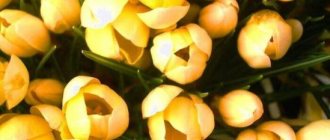1.Description
This perennial shrub has a powerful, branched rhizome, straight, weakly branched shoots and dark green, narrow, pointed leaves.
During the flowering period, fluffy umbrellas are formed on the tops of the shoots - inflorescences up to 25 cm in diameter. The flowers are small, with numerous stamens, fluffy, and come in white, pink, lilac or violet.
Faded inflorescences become silvery-white; after flowering, fruits are formed - achenes with a single seed.
Pokonnik is an excellent honey plant with a sweetish aroma.
Height . The height of the plant depends on the specific species and can vary from 1.5 to 2.5 m.
↑ Up,
When and how does it bloom
The most popular types of window sills are:
- hemp, which received its name for its similarity with hemp leaves;
- The wrinkled species is divided into several varieties. For example, the wrinkled Chocolate variety with black leaves is popular. Also known is the Braunlaub variety, which has brown leaves and buds;
- purple with bluish-green stems and shield-shaped inflorescences;
- spotted sapling has several varieties, among them the spectacular spreading Atropurpureum with strong stems and wine-red flowers;
- The tubular appearance is distinguished by the Album variety, which grows into trapezoidal upright bushes three meters high.
Flowering period
Flower blooming time is August and September.
For your information! The plants also attract attention in October, when they appear with a silvery tint and fruits with seeds. The smell of vanilla is present throughout the growing season
Changes in care during the flowering period
Once flowering begins, caring for it is no more difficult than usual. The condition of the soil, namely its moisture, should be monitored, and weeds should be removed as they appear on the site.
Planting perennials vegetatively
3.Planting and care in open ground
When growing in the garden, humid places located near small bodies of water are suitable for sills.
↑ Up,
3.1.How and when to plant
Planting in open ground is carried out using seedlings. First, the area is loosened, stones and weeds are removed, fertilizer is added for flowering plants, then planting holes are made. Between planting holes, such a distance is left so that a gap of 60 - 70 cm is maintained between plants.
A day before planting, the seedlings are watered abundantly to soften the root ball, then, keeping the earthen ball, they are planted in planting holes, covered with earth, which is then lightly compacted to remove air pockets. Flowers planted in the garden are watered abundantly with warm water.
↑ Up,
3.2.How to care for the window sill in the garden
The plant can be in the same place for more than 5 years and will only gain attractiveness. Mature bushes more than 5 years old will require replanting. When grown in the garden, the sapling loves abundant watering and loose soil, which easily allows water and air to pass through to the root system. In order to retard the growth of weeds, the bases of plants are mulched with peat, sawdust or hay.
For abundant and long-lasting flowering, plants will need feeding throughout the season. 1 is carried out in the spring, with the formation of the first leaves, and the second is done before the formation of the first buds in the summer.
↑ Up,
3.3. Shelter for the winter
When grown in the conditions of the Middle Zone, the sapling will not require shelter for the winter and will tolerate it quite easily. The first young shoots will appear on these plants quite late, in May.
↑ Up,
Moisturizing and fertilizing
This plant prefers frequent moisture. A place next to a pond will suit him very well. It has been noted that a slight stagnation of moisture in the window sill will not cause as much harm as drought.
After heavy watering or rain, it is recommended to loosen the soil near the plant trunk to prevent the formation of a crust on the ground. At the same time, you can remove weeds growing in the neighborhood.
Poskonnik - a handsome healer - video
Complex mineral complexes similar to the following products are suitable for feeding the saplings: “Zdraven”, Nitroammofoska” and “Fertika Lux”. A plant that has received sufficient nutrition has a different appearance. Shine appears on its foliage, the foliage acquires a rich color, and the open buds delight with colors.
In one season, the sill needs to be fertilized three times. The first time this should be done is at the beginning of the season. The second time, fertilizers are applied at the time of budding, and the last time, mineral additives are introduced into the soil after the sapling has faded. If there are no mineral complexes at hand, the plant will respond well to fertilizing with mullein, humus or wood ash.
6.Use in landscape design
Gardeners love to use this beautiful, tall plant in landscape compositions; it looks good in the background, near fences and near ponds. Often the window sill grows as a compact bush and does not require support.
A distinctive feature of the plant is that it does not suppress other flowers. When grown in the garden, the sapling successfully develops both in a well-lit area and in partial shade.
↑ Up,
Diseases and pests
Lush sapling bushes are endowed with resistance to diseases and immunity from pests.
Although they cannot resist the miners. The miner is dangerous because it settles inside the leaf plate and makes “movements” in it. They can be detected by looking closely at the leaf. To save the bush, it is worth collecting damaged leaves and burning them.
Only the most effective insecticidal agents will help you get rid of other insects that are invisible to the eye. For example, "Aktellik". Before processing, damaged shoots are cut off from the bush. If the window sill has not had time to suffer much from the miner, it will recover quickly.
7. Reproduction
7.1.Growing from seeds
Saplings are propagated by seeds, which are sown in March for seedlings. For seedlings, take flower pots, arrange drainage in the form of expanded clay, broken bricks or clay shards and fill them with loose, nutritious flower soil.
The soil is watered abundantly, and the seeds are sown, covering them with a layer of soil 7-10 mm thick. To create a greenhouse effect and maintain high air humidity, the seedlings are covered with a transparent film on top and left in a warm, illuminated place.
↑ Up,
2 - 3 weeks after sowing, the first shoots appear, at which time the cover can be completely removed.
Plants are planted in separate containers if sowing was carried out in seedling boxes. The best time for picketing is the period when each bush can boast of real 4 leaf blades.
↑ Up,
The first buds will appear on plants grown from seeds after 3 years.
Seed propagation is quite easy and when grown in open ground under mature bushes, you can even find self-seeding young plants.
↑ Up,
7.2.Cuttings
The sapling can be propagated vegetatively or by cuttings. At the beginning of summer, half-ripe stem cuttings are separated from the main plants with a sharp, sterilized garden tool - pruning shears or a knife. Each cutting should have 3 leaf nodes.
The bases of the cuttings are powdered with powders containing plant growth hormones and immersed in loose soil consisting of peat and river sand, 1 cm deep at a slight angle.
↑ Up,
Within a month, signs of new growth can be seen at the base of the cuttings - this will indicate that the first roots have appeared under the surface of the soil. In August, such plants can be transplanted into open ground.
↑ Up,
7.3 Division
Adult specimens can be propagated by division during transplantation. To carry out the procedure, plants are dug up and the root system is shaken off the ground.
They mark the location of the division, making sure that each division receives its own root system and a well-developed above-ground part.
Dividing an adult sapling is not an easy task, since the bases of the stems become thick and woody with age, which means you may even have to use an ax or saw.
↑ Up,
Caring for spotted saplings
This is not a capricious plant at all, but for beautiful flowering you should still take care of it. The sapling likes to grow on loose soils, so the soil must be regularly loosened and then mulched. But you should not fluff the soil too deeply, so as not to damage the roots.
Basic rules of care:
- Watering plants. Since the plant loves moisture, it must be watered regularly. If the planting site is arranged correctly, with drainage, then overflows are not a problem.
- Feeding flowers. Fertilization of the sill is carried out twice a season, during its growing season. The first time fertilizing is done in early spring, and the second time at the very end of June or when the plant lays buds. You can use mineral mixtures, for example Nitroammofoska, Kemira Lux, Zdraven is also suitable.
- Trimming. The plant is wonderful because it does not need systematic pruning while it is growing green mass or blooming. Its branches die off on their own with the onset of autumn.
- Preparing for winter. With the onset of cold weather, the bushes are pruned so that there are about 15 cm of stems above the soil surface. This flower tolerates sub-zero temperatures well, so it does not require additional insulation. The youngest specimens are covered with spruce branches. The window sill begins to produce new shoots only when it is already quite warm. The flower finally wakes up towards the end of spring, and then actively grows.
- Transfer. The plant does not really like to be disturbed frequently by replanting. This makes it much less decorative. The flower should be planted in the spring before it produces shoots.
If you follow all the rules of planting and care, then the first flowering can be observed already in the third year of the sill’s life.
The flower forms tall bushes that need staking. It is especially important to do this after heavy rains, when the stems with large inflorescences heavy with water begin to bend strongly. To make this easier, it is better to plant the plant along the walls of the house or near a fence.
9.Healing properties
In folk medicine, all parts of the plant are used - leaves, roots and inflorescences. Sapwood is used as an anti-inflammatory, diaphoretic, expectorant, analgesic, wound-healing, and laxative.
Various ointments, tinctures and decoctions are prepared based on the extracts of this shrub.
↑ Up,
There are also some contraindications when using sapwood for medical purposes. Since all parts of the plant are poisonous, extreme caution must be taken and taken under the supervision of doctors. It is prohibited to give plant-based products to children under 18 years of age.
↑ Up,
Combination of window sill with other plants
Sills are widely used in landscape design due to their decorative properties. They are often planted in groups; they hide buildings and fences well, and also visually enlarge the space.
But besides this, they look great with other plants. They harmonize perfectly with black cohosh, astilbe, and echinacea, and rudbeckia, buzulnik, and helenium provide a good contrast with the saplings.
The use of window sill is primarily due to its lush inflorescences, which are visible from great distances. However, the leaves of this plant also have excellent decorative properties.
10.Varieties and types of window sill:
10.1. Purple sapling - Eupatorium purpureum
Purple sapling is a fairly popular species in floriculture; it is a perennial shrub up to 2 m high. The plant grows quickly, forming entire colonies. The main decoration of bushes of this type are flowers that do not fall off for a long time and are pleasing to the eye.
The inflorescences reach a diameter of 30 cm. The rhizome is well developed. The leaves are green with purple veins. In its natural environment it prefers to grow along river banks and in meadows.
↑ Up,
10.2.Spotted sapling - Eupatorium maculatum
This North American representative of the genus got its name from the spots on the stem of different colors. The plants reach a height of 2 m; they prefer to settle in damp places. During the flowering period, purple or pink flowers are formed. The leaves are elongated, collected in whorls - four leaf blades are attached in a circle to one leaf node.
↑ Up,
10.2.1.Spotted Riesenschirm - Eupatorium maculatum Riesenschirm
A flowering perennial up to 150 cm high with delicate pink buds at the top of erect, strong shoots. The flowering period begins in the second half of summer and lasts until October. After flowering, fluffy white seeds form in place of the buds.
↑ Up,
10.3. Wrinkled sable - Eupatorium rugosa
Perennial plants up to 150 cm high, with increased frost resistance. The leaves of this variety are oval in shape, framed by small teeth with a purple tint. The corymbose inflorescences reach a diameter of 15 cm and consist of many small white flowers. The flowering period begins late - at the end of August. When grown in open ground, it requires support. This shrub is quite moisture-loving.
↑ Up,
10.4. Hemp sapling - Eupatorium cannabinus
Hemp sapling got its name for its external resemblance to hemp leaves. Plants of this species form powerful rhizomes and erect shoots up to one and a half meters high. The flowers are light pink, collected in corymbose inflorescences. In its natural habitat it prefers important and even slightly marshy spaces.
Description and characteristics of the plant
The sapling (Eupatorium cannabinum L.) is a species of plant in the aster family (Asteraceae Dum.). The Russian name of the perennial comes from the word poskon (hemp), other names are also known in the world - hemp, water marjoram, hemp marjoram, St. John's grass, windy rose. The plant grows wild in Europe, large parts of Asia, Algeria, and Morocco.
This is an extremely impressive, leafy perennial. The plant is frost-resistant, so you can easily grow saplings in the Moscow region, the middle zone and many other regions.
The stem is smooth, erect, 50-170 cm high, covered with short hairs on top, grooved, reddish, rarely branched, often hollow.
The leaves are dark green, opposite, trifoliate, lanceolate, 5-15 cm long, 1-4 cm wide, pointed, the edges are often jagged. The lower leaves are short-petiolate, the upper ones are sometimes sessile, arranged in a circle of four.
The flowers of the sapling are bisexual, tubular, cylindrical, small, 5-6 mm long, 1.5-2.5 mm wide, collected in 3-7 flower baskets, forming dense clusters with a diameter of 7.5 cm. The pistil is elongated.
The crown of the flower is dirty pink, sometimes white or purple, quite deep, with five funnel-shaped teeth. The calyx is 3-5 mm long, the hairs are arranged in one row.
The sapling blooms from the first ten days of July until August - 7 weeks. Flowers emit a pleasant smell, attracting various insects. The plant is an excellent honey plant and attracts bees and butterflies to the garden.
The fruit is a red-brown achene, 2-3 mm long, 0.5-1 mm wide. The seeds are spread by the wind.
Habitat – grows on the banks of water bodies, in wet meadows, edges of wet forests, in thickets, wet forests, meadows, ditches.
It is worth knowing that... The essential oils contained in the plant attract bees, bumblebees, and butterflies.
Thanks to its beautiful inflorescences, sapling can be grown as an ornamental plant. In addition to the natural form, ornamental varieties are grown.
Replanting the sill
Plant transplants are rarely carried out, since window sill bushes retain their decorative appearance for up to 10 years. Due to the fact that the rhizome of this plant is strong and quickly becomes woody, the procedure of replanting and dividing, which are carried out together, is quite problematic.
It is better to start the procedure in the spring. To begin with, the shoots need to be trimmed so that they become approximately 20 cm in height. After this, the root is divided, but this is difficult to do, so you can even resort to an ax. When dividing, you need to make sure that there are at least three buds on each part.
The cuttings are treated with charcoal and transplanted to places suitable for growing adult plants.
How to choose the right window sill when purchasing
If you decide to purchase window sill flowers for your garden, then you need to be very careful. You can purchase sapling rhizomes or seedlings. In both cases, you need to know some points in order to choose high-quality seed.
What to look for when buying sapling rhizomes
Usually the rhizomes are packaged in transparent packaging, thanks to which it can and should be examined carefully. The roots should not be brittle, but elastic.
If the purchase is made in the spring, then young buds should be visible on the rhizome. Also carefully inspect the rhizome for signs of rot, mold or insect damage.
What to look for when buying sill seedlings
When purchasing seedlings, a detailed description of what high-quality sill planting material should look like will help you.
First of all, you should pay attention to the root system. If it is not strong enough, the seedlings may not take root and the plants will die.
Of course, the leaves must be strong and elastic, and the earthen ball must be moist.
Landing Features
When planted in open beds, the sapling exhibits tiny flowers that appear in clusters in late summer or early fall.
Most often it can be found in fields and meadows, but it is not difficult to grow a flower in the garden.
Seeds can be sprouted indoors or outdoors after the last frost has hit. There are several benefits to growing indoors. Being very tiny in size, the seeds will not be washed away by rain or eaten by birds. It is easier for the gardener to maintain proper soil moisture levels once they enter the germination stage.
The window sill will grow well in partial shade, as well as in a place where there is a lot of sunlight. The plants are quite tall, and its branches extend up to 1 meter wide, so it is worth keeping a free space of about two meters between them. The shoots of the bush are strong and do not require support in the form of trellises. Watering once a week is sufficient, twice a week during dry periods.
Planting time largely depends on what planting material the gardener has chosen. If this is a rhizome, then all the work is transferred to mid-spring, when there will definitely be no major frosts. There will be enough time during the warm period for the bush to take root and prepare for wintering. If seedlings are planted, then this is exclusively the beginning of summer , when the air temperature is already warm around the clock. Seeds are planted in early spring.
When choosing a suitable location, it is better to stay where there is enough sun during the day, since in its absence the bush may stop blooming.
The soil must have proper drainage. In addition, the soil is additionally fertilized. If it is sandy soil, which is very poor in the presence of useful microelements, manure is used. Before planting, the area is dug up and stones, if any, are removed. They do not allow the roots to develop well, and as a result, the entire bush suffers.
You can use bone meal as an additional fertilizer. When planting several shrubs in the form of rhizomes, they are buried in the ground by at least 5 centimeters. It would be nice to mulch using peat, humus or sawdust, which is laid on top. This method allows additionally to provide good protection against moisture loss and weed germination.
The first waterings are carried out more often, the main thing is to achieve rooting of the plant. Planting holes also need to be prepared for planting seedlings.
It is advisable to put fertilizer inside, since such seed is more capricious than a simple rhizome. You can use not only bone meal, but also ash or even humus. Or you can use all three components in a ratio of 1: 3: 6. An adult sapling is a very frost-resistant plant that can tolerate temperatures down to -25° C.
Rules for planting window sills in the country
Typically, sills are planted with seedlings, cuttings or rhizomes after warm weather sets in:
- At the designated locations, dig holes 0.25 m deep.
- Pour in humus and bone meal, about a handful each.
- Carefully remove the seedlings from the containers, being careful not to damage the stems and roots.
- Lightly stir the earthen lump on the roots so that they straighten out: this way the plant will grow faster.
- Place in the hole and cover with soil so that the growth bud is covered by 5 cm; this will protect the seedling from freezing in winter.
- Water, being careful not to disturb the soil around the seedling.
- Cover the tree trunk circle with a layer of mulch made from sawdust, humus or peat, this will maintain soil moisture and prevent weeds from growing.
Until the plant takes root, you should water it more often, not allowing the soil to dry out.
The sapling is responsive to fertilization, but you can start fertilizing only after rooting.
Feed with complex mineral fertilizers such as Kemira Lux, Zdraven, nitroammofoska, after making an aqueous solution based on them.











